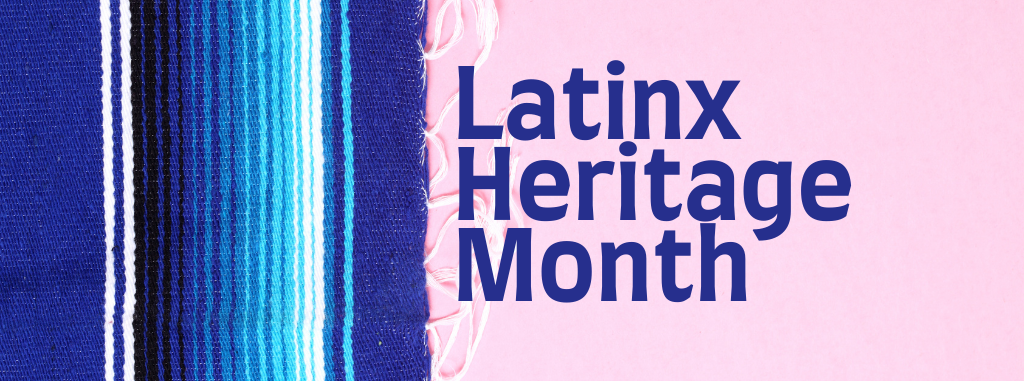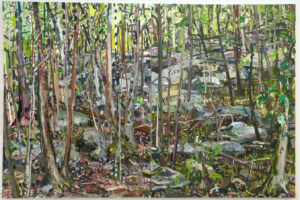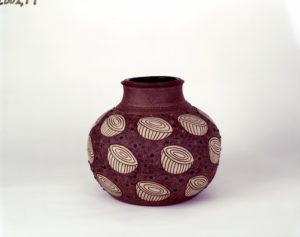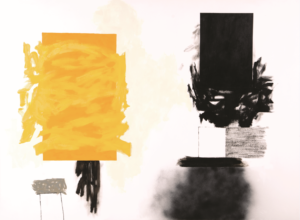
The Huntsville Museum of Art is highlighting several artists who have works in the collection during Latinx Heritage Month. Many of these artists have works on display right now, and some are local to Huntsville. Read along to meet five different artists and learn more about their backgrounds. Then visit the Museum to see their works in person.
Lilian Garcia-Roig
Tallahassee, Florida

Lilian Garcia-Roig (b. 1966, Havana, Cuba), Painted Paint Rock, 2008, oil on canvas, 48 x 72 in. Museum Purchase, Funds Provided by the SPACE 300 Acquisition Fund.
Born in Havana, Cuba in 1966, Lillian Garcia-Roig was raised and worked in Texas for 30 years but now lives and works in Tallahassee, Florida. She was a featured Encounters artist at the Huntsville Museum of Art in 2008, and is now in the Museum’s permanent collection.
In 2021, she was named a Guggenheim Fellow in Fine Arts. Other major awards include a Joan Mitchell Foundation Award in Painting, a Mid-America Arts Alliance/NEA Fellowship Award in Painting, State of Florida Individual Artist Fellowship Award in painting, and a Kimbrough Award from the Dallas Museum of Art. She has shown nationally at such places as the Americas Society Gallery in NYC, the National Museum of Women in the Arts and the Art Museum of the Americas, both in Washington D.C and extensively in the south, especially in Texas and Florida. Internationally, she has shown at the Chopo Museum in Mexico City and Byblos Art Gallery in Verona, Italy. She had a large work included in Relational Undercurrents: Contemporary Art of the Caribbean Archipelago that opened in 2017 at the Museum of Latin American Art in Long Beach as one of the Getty funded Pacific Standard Time: LA/LA exhibitions which traveled to several museums across the country through 2019. Recently, she was included in the 2019 Florida Prize in Contemporary Art exhibition at the Orlando Museum of Art and in the Florida Contemporary at the Baker Museum in Naples.
Artist Statement:
As an on-site painter, place is integral to both my subject and process. I make large, often multiple panel on-site oil painting installations of dense landscapes that overwhelm the viewer’s perceptual senses. Each individual painting is created over the course of the day in an intense, wet-on-wet cumulative manner that underscores the complex nature of trying to capture the multidimensional and ever-changing experience of being in that specific location over time.
Formally, the works are about the materiality of the paint and the physicality of the painting process in which the figure and the ground are actively exchanging places. This highlights the contrast and interplay between the illusionist possibilities of painting and its true abstract and material nature while also alluding to the active, perceptual experience one has when negotiating actual 3-D spaces. From a distance, I draw the viewer into what is first perceived as a dense but conventional space. Up close, however, the images break down; the lush, gestural paint marks, squeezed-out paint patches and areas of raw canvas help, instead, to reinforce the 2-D character of abstract painting as both an activity and an end-product. Ultimately my “all-day” plein-air paintings have become documents of a real-time process: the accumulation of fleeting moments, the experience of the day.
On a more personal level, I have realized that all of the on-site works I’ve made in the U.S. have been about trying to negotiate the complex propositions of sense of place and belonging which so influence the construction of personal identity. I am drawn to wilderness out of a deep psychological need to connect. In America, I am uninterested in conventional vistas, and it is in seemingly unclaimed or raw, dense natural spaces that I feel the most at home, where I am temporarily invited yet never fully allowed to enter.
I believe this comfort with, and parallel aesthetic attraction to, complex spaces comes from my background as a Cuban refugee. As a first generation immigrant, I had to be open to seeing things from at least two culturally distinct, and often opposing, perspectives. Unsurprisingly, these identity struggles are common themes in Latin American art of the last few decades, in which the postmodern Latin American subject is fragmented and fluid, with multiple unresolved and at times contradictory identities. It turns out my creative work, like my life, has always been about improvisation and reconciliation.
Like my Cuban-American identity, my work can be broken down into two distinct but interrelated categories: the American-made works (30 years’-worth) and the very new and developing Cuban-made/inspired works that explore the idea of a hyphenated-nature and offer a more conceptual approach in reconciling my Cuban and American pictorial and personal identities.
Victor Gomez
Miami, FL

Victor Gomez (b. 1941, Havana, Cuba), Beyond Expected, 2020, oil monotype, 22.5 x 33.5 in. Museum Purchase, Funs Provided by the Dr. John Rison Jones, Jr. Acquisition Fund and the Susy & Robert Thurber Acquisition Fund.
Recent Acquisitions 2021 right now, Red Clay Survey 2020
Victor Gomez is an enthusiastic painter and printmaker with a long artistic trajectory. His work is in the Museum’s permanent collection, currently on display in the 2021 Recent Acquisitions exhibition. He was also recently included in the 2020 Red Clay Survey. Gomez has received more than fifteen international awards in the monotype printmaking technique. He has conducted several workshops in the United States and abroad, introducing his fascinating technique to many colleges. Since 1991, Gomez has maintained a profuse participation in international printmaking events. He has been selected in Japan, China, Taiwan, New Zealand, Portugal, Spain, Germany, Italy, Romania, the United States, Puerto Rico, Mexico, Canada, Argentina and of course Cuba. He was invited in 2011 and 2012 to participate in the Resident Artist Program, sponsored by the Printmaking Base of Guanlan, Shenshen, China. His work is in many public and private collections all over the world, as well as many museums and art centers. Coinciding with the development of his personal work, he has published more than 39 Cuban artists in the serigraphy technique at his printmaking workshop, Miami Press.
Artist Statement:
After venturing through different expressive ways, I reached a point where I commenced to get away from reality and lose interest in it. I then decided to delve into the world of forms in themselves, without trying to convey a message or idea other than the mere formal joy of my work, making an emphasis on the designs that my mind has drawn from my formal experiences. I do not want to repeat or recreate reality but rather to shape my inner restlessness and accumulated knowledge to create formal solutions that collect all my life experiences as an artist, joining my old path with the new one to come.
Guadalupe Lanning Robinson
Huntsville, AL

Guadalupe Robinson (b. 1954, Mexico City, Mexico), Untitled, 2002, embedded stoneware, 11 x 13 x 13 in. Museum Purchase in memory of Juan Martinez Reyes.
Guadalupe Robinson is a ceramist based locally in Huntsville. She was born in Mexico City and has a ceramics degree from Centro de Artes Plásticas y Artesanias Independencia. Robinson has a studio in Lowe Mill, where she creates pottery and quilts. Her work is included in the Museum’s permanent collection and was on display in 2015 in the exhibition Celebrating Our Own: Huntsville Women Artists. Robinson has also been exhibited at the Wiregrass Museum of Art and the Alabama Center for the Arts. In 2017, she received the Nashville Arts Stand Out Winner award from the Tennessee Crafts Fair.
Artist Statement:
A great fascination with different colored clays and the textures that can be produced with stoneware has led me to experiment with and study clays for the past thirty years.
I was born and grew up in Mexico City, a place with strong cultural ties and great tradition, full of sights, energy, sounds and flavor.
Bringing together my Mexican heritage with the richness and tranquility of the Deep South has enriched my life. This constantly moves my work toward blending the two cultures.
Continuous respect for the material is a factor I try to maintain in my work. I also have a great reverence for the idea of “craftsmanship” and it is a strong element when creating my work. My work has developed from the respect I have for clay and the joy I experience when working with it
Aimee Perez
Miami, FL

Aimee Perez (b. 1955, Havana, Cuba), Rare Harvest, 2016, mixed media, 65 x 13 x 13 in. Museum Purchase, Funds Provided by the Dr. John Rison Jones, Jr. Acquisitions Endowment and the Susy and Robert Thurber Acquisitions Endowment.
Aimee Perez was born in Habana, Cuba in 1955. She left for the United States when she was twelve with her family through the Freedom Flights and grew up in Miami in the Cuban immigrant community. As a young adult, she won the Gold Key Award in painting. Perez received several other honorable mentions as she continued her pursuit of the arts during her college years. In 1989, she moved to Mexico City and continued painting and exhibiting with Cuban and Mexican artists. In 1997, she was invited to participate as a guest artist in the studio of Mexican sculptor Jose Sacal, where she began to work in 3-D with clay for the first time. She returned to Miami in 2006 and continued her work, winning several awards for her figurative ceramics in the state of Florida. Perez has been praised for her command of gestures, making her sculptures expressionistic and powerful. She says her work is her voice, a dialogue with the observer and simultaneously a self-exploration. Her work is in the Huntsville Museum of Art’s permanent collection, and she has been on display many times. She was included in the Red Clay Survey in 2017 and Recent Acquisitions in 2018. Perez will also be a 2022 featured artist in the Encounters exhibition series.
Artist Statement:
I work with human forms – with the gestures and emotions, lives and relationships – that serve as archetypes by transcending the context of their story. Through the exploration of contemporary, religious and biblical themes, I create sculptures that explore spiritual truth and the paradoxical truths of suffering and redemption, grief and comfort. The mediums I use include various types of clays fired at high or low temperatures and surfaced with oxide washes, slips, terra sigillata, engobes and glazes. I have also been known to to add encaustic, wax, metals, glass, and found objects to add layers to a piece.
Rocío Rodríguez
Atlanta, GA

Rocío Rodríguez (b. 1952, Caibarién, Las Villas, Cuba), Big Yellow, Big Black, 2013, oil on canvas, 66 x 95.5 in. Museum Purchase, Funds Provided by the Dr. John Rison Jones, Jr. Endowment and the Susy and Robert Thurber Endowment.

